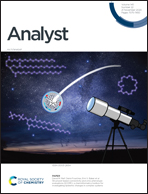A single-component yet multifunctional tongue-mimicking sensor array for upconversion fluorescence biosensing†
Abstract
In this work, we prepared a type of multiplexing upconversion nanoparticle (UCNP). There are three fluorescence emission peaks when our UCNPs are excited with 980 and 808 nm lasers. These fluorescence peaks of UCNPs can be quenched (“turn off”) to varying degrees via fluorescence resonance energy transfer (FRET) when the UCNPs are coated with a polydopamine (PDA) layer, which is a universal quencher self-polymerized from dopamine (DA). Here, we create a novel single-component nanoprobe that can be used for the pattern recognition of antioxidants in a “turn on” manner by integrating with the prevention of PDA formation with an antioxidant. Our sensing strategy is based on the recovery of the fluorescence intensity of three emission peaks to different degrees due to different antioxidants with differential inhibition of PDA formation. Then, these three fluorescence emission peaks of UCNPs are innovatively selected as the sensor array, which enables us to discriminate multiple antioxidants and their mixtures. Simultaneously, the sensor array shows excellent performance in the chiral discrimination of cysteine enantiomers. This is a novel, innovative sensor array that requires only a single component to achieve the upconversion fluorescence pattern and recognize chiral molecules, and it elucidates a more innovative concept towards widespread applications.



 Please wait while we load your content...
Please wait while we load your content...